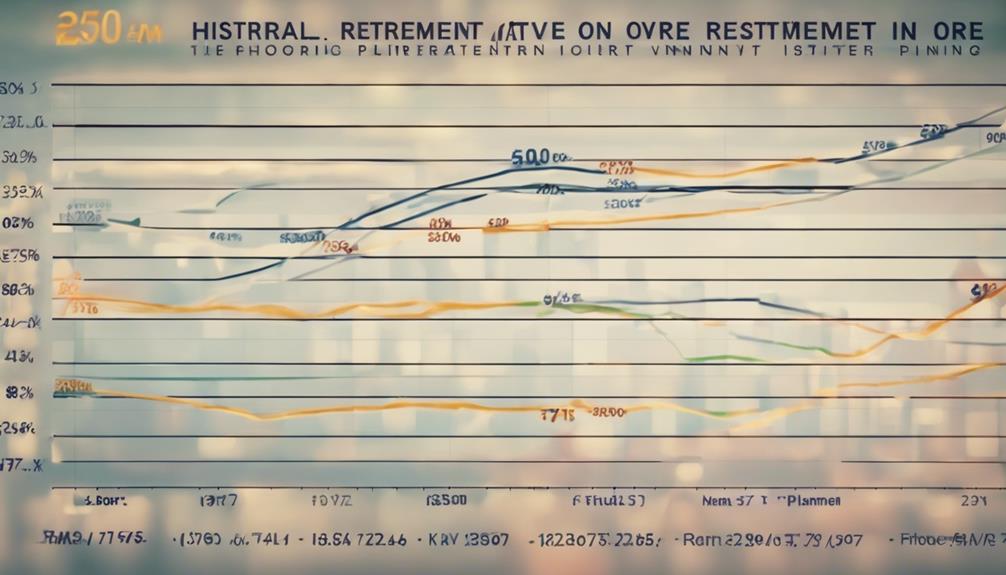Retirement Planning
Avoid These Retirement Planning Misconceptions: Which Ones to Watch For?
Prepare for a secure retirement by avoiding common misconceptions, such as underestimating inflation's impact and planning for healthcare expenses beyond Medicare – learn more to safeguard your financial future.

Avoid these common misunderstandings about retirement planning to protect your financial future. Be cautious of underestimating the impact of inflation on your savings; adjust your income to counteract it. Embrace flexible budgeting to adjust as your needs change, improving your financial stability. Plan for healthcare expenses that go beyond Medicare coverage by looking into insurance options and long-term care strategies. Regularly review withdrawal rates to ensure your future income needs are met. Understand the limitations of Medicare and seek advice on supplemental coverage. Diversify your sources of income to offset uncertainties surrounding Social Security. Consider downsizing to save costs and research different options for senior living. Consult with experts to create a well-rounded retirement plan. Find out more about these important insights for a secure future.
Key Takeaways
- Failure to adjust for inflation can diminish savings over time.
- Underestimating healthcare expenses can jeopardize financial security.
- Relying solely on Social Security may not be sufficient for retirement.
- Ignoring changing market conditions can impact long-term financial stability.
- Misconceptions about retirement living arrangements can lead to unexpected costs.
Inflation Impact on Retirement Savings
When preparing for retirement, understanding how inflation can affect our savings is vital for securing a comfortable future. Inflation impact plays a significant role in retirement planning as it can gradually diminish the purchasing power of our hard-earned savings.
Historically averaging around 3% annually, inflation has the potential to double expenses in about 24 years, emphasizing the importance of adjusting retirement income to combat its effects.
Failing to take into account inflation in our retirement planning could lead to a substantial decrease in the value of our savings over time, making it challenging to cover essential expenses. By incorporating strategies to protect against the rising costs of goods and services, we can safeguard our financial well-being in retirement.
It's essential to plan proactively, considering inflation and ensuring that our retirement savings will be sufficient to maintain our desired standard of living throughout our golden years.
Importance of Flexible Budgeting

As we prepare for retirement, understanding the impact of flexible budgeting becomes key in maintaining financial stability and adaptability. Flexible budgeting allows us to balance our spending effectively, avoiding financial shortfalls and ensuring our retirement savings last longer. By adjusting our spending levels based on changing circumstances and needs during retirement, we can better adapt to unexpected expenses or income fluctuations. This adaptability with budgeting not only helps us prioritize essential expenses but also enables us to enjoy our desired lifestyle without compromising our financial resilience.
| Benefits of Flexible Budgeting |
|---|
| Balances spending effectively |
| Helps adapt to changing needs |
| Enhances financial resilience |
Preparing for Healthcare Expenses

When planning for retirement, it's important to take into account healthcare expenses that Medicare may not cover, like deductibles, copayments, and long-term care. To address these potential gaps, exploring cost-effective insurance options and long-term care planning strategies can help guarantee thorough coverage.
Consulting with financial advisors can provide valuable insights on estimating and preparing for healthcare costs in retirement, guiding you towards a secure financial future.
Cost-Effective Insurance Options
To effectively prepare for healthcare expenses in retirement, exploring cost-effective insurance options is essential. When considering insurance options to cover health care costs, individuals should keep the following in mind:
- Medicare Supplement Insurance: Helps fill the gaps in coverage left by Medicare, such as copayments and deductibles.
- Extensive Plans: Offer thorough coverage beyond basic Medicare benefits, including dental and vision services.
- Hybrid Policies: Combine long-term care coverage with life insurance, providing a dual benefit for healthcare expenses and financial security.
Long-Term Care Planning
Exploring long-term care planning is a proactive approach to preparing for healthcare expenses in retirement. When contemplating long-term care, it's important to understand the potential costs and how they can impact retirement savings.
Long-term care insurance is a valuable tool that can help cover expenses such as in-home care, assisted living facilities, and nursing homes, providing a vital financial safety net. While Medicare doesn't typically cover long-term care costs, Medicaid may be an option for those with limited financial resources. However, eligibility criteria vary by state.
Planning for long-term care isn't only about financial protection but also about ensuring quality care in later years. It's crucial to take into account these factors when developing a thorough retirement plan.
Revisiting Withdrawal Rate Necessity

Regularly reassessing withdrawal rates is crucial for maintaining financial stability in retirement or as one nears retirement age. To guarantee a robust retirement plan, it's essential to revisit withdrawal rates periodically, especially considering the following:
- Maximizing Investment Portfolio: By adjusting withdrawal rates, individuals can optimize their investment portfolio's performance, potentially extending its sustainability over the long term.
- Adapting to Market Changes: Market fluctuations can impact retirement savings. Revisiting withdrawal rates allows for adjustments to align with changing market conditions, safeguarding financial security.
- Securing Future Income Needs: By reassessing withdrawal rates, retirees can better align their withdrawals with their future income needs, ensuring a steady stream of funds throughout retirement.
Incorporating these practices into your retirement planning can help you navigate uncertainties and maintain control over your financial future. Consulting with a financial advisor can further refine your withdrawal strategy to suit your specific circumstances and goals.
Understanding Medicare Coverage Limits

Revisiting withdrawal rates can shed light on the gaps in Medicare coverage limits, particularly concerning deductibles, copayments, and other expenses not included in traditional Medicare.
Medicare, while essential for healthcare coverage in retirement, doesn't cover everything. Expenses like deductibles, copayments, dental, vision, and long-term care aren't included.
To bridge these gaps, consider options such as Medicare supplement insurance, Advantage plans, living benefits riders, or hybrid policies. These additional coverages can help manage healthcare costs not accounted for by traditional Medicare.
Private issuers also offer plans to assist in covering remaining healthcare expenses. When planning for retirement, it's important to consult with financial advisors who can estimate and prepare for these healthcare costs.
Advisors play a significant role in factoring in healthcare expenses, identifying gaps in Medicare coverage, and recommending solutions to ensure thorough coverage for all healthcare needs in retirement.
Longevity of Social Security Benefits

When thinking about retirement planning, it's essential to address the longevity of Social Security benefits.
With the trust fund potentially running out by 2037, there are concerns about the sustainability of benefits in the future.
This uncertainty emphasizes the importance of supplementing Social Security with personal savings to guarantee a comfortable retirement.
Social Security Longevity
Ensuring the longevity of Social Security benefits requires careful consideration of additional income sources beyond Social Security alone. When planning for retirement income, it's important to remember that Social Security solvency issues could impact future benefits. Relying solely on Social Security may not provide enough financial support for most retirees.
To secure a stable retirement, financial advisors recommend diversifying income sources and staying informed about changes in Social Security policies. By incorporating multiple income streams, individuals can better safeguard their financial future.
Here are three key points to remember when thinking about Social Security longevity:
- Diversify Income Sources: Avoid relying solely on Social Security for retirement funds.
- Stay Informed: Keep track of any changes in Social Security policies that may affect benefits.
- Consult Advisors: Seek guidance from financial experts to develop a balanced retirement income plan.
Benefit Sustainability Concerns
To maintain financial stability in retirement, it's essential to address concerns regarding the sustainability of Social Security benefits. While the Social Security trust fund may face depletion by 2037, ongoing taxes will continue to fund benefits. Despite solvency worries, it's projected that Social Security will still pay approximately 75-80% of promised benefits.
To secure a comfortable retirement, supplementing Social Security with personal savings is important. Financial advisors play a crucial role in tracking changes in Social Security and adjusting income strategies accordingly. It's prudent to view Social Security as an important, though not sole, income source in retirement planning.
Seeking expert financial advice can help individuals navigate uncertainties surrounding their retirement fund and make informed decisions for a financially secure future.
Future Funding Uncertainties
Amidst the uncertainties surrounding the longevity of Social Security benefits, a proactive approach to retirement planning is essential for ensuring financial stability in the future. To navigate the potential impact of market conditions and the future of Social Security benefits, individuals should consider the following:
- Stay Informed: Keeping abreast of changes in Social Security can help adjust retirement income strategies effectively.
- Diversify Retirement Accounts: Supplementing Social Security with personal savings can mitigate the impact of reduced benefits.
- Adapt to Market Conditions: Being flexible and adjusting investment strategies according to market fluctuations is crucial for long-term financial security.
Addressing Changing Retirement Living Arrangements

Exploring various choices for retirement living arrangements is an important aspect of thorough retirement planning. When planning for retirement, it's vital to take into account the implications of changing your living situation.
Downsizing can help reduce housing costs and maintenance, providing financial relief. Some retirees find convenience and social interaction in senior living communities or assisted living facilities.
Renting during retirement offers flexibility and removes the burdens of homeownership. However, relocating to a different state or country can impact taxes, healthcare access, and overall cost of living.
To address changing retirement living arrangements effectively, carefully assess your financial situation and lifestyle preferences. Consider the long-term impact of these decisions on your retirement funds and quality of life.
Frequently Asked Questions
What Are the 7 Crucial Mistakes of Retirement Planning?
We identify important retirement planning mistakes: overlooking healthcare costs, relying only on Social Security, planning to work indefinitely, underestimating expenses and taxes, and assuming a fixed location. Be proactive to secure financial stability.
What Are 3 Things to Consider When Planning for Retirement?
When planning for retirement, we must carefully consider our desired lifestyle, current financial status, and potential expenses. It's essential to paint a vivid picture of our future needs to create a robust retirement plan.
What Is the Number 1 Retirement Mistake?
Not revisiting withdrawal rates regularly can jeopardize financial stability. Ignoring healthcare costs not covered by Medicare is a common oversight. Relying solely on Social Security without supplemental savings is risky. Planning to work indefinitely without a backup is shortsighted.
What Are Some Mistakes When Investing for Retirement and How to Avoid Them?
When investing for retirement, some mistakes include overlooking fees, failing to diversify, ignoring asset allocation, timing the market, and not adjusting strategy. To avoid them, research fees, diversify, allocate assets wisely, avoid market timing, and adapt strategies.
Conclusion
Just as a gardener tends to their plants with care and attention, we must nurture our retirement savings to guarantee a fruitful harvest in our golden years.
By avoiding common misconceptions and staying informed about the realities of retirement planning, we can cultivate a secure and comfortable future for ourselves.
Let's plant the seeds of financial wisdom today, so we may reap the benefits of a bountiful retirement tomorrow.
Lawrence founded The Liberty Portfolio to make complex retirement planning accessible to everyone. With extensive experience in investment strategies and financial planning, he leads our strategic direction and ensures that our offerings are aligned with the latest economic trends and regulations. Lawrence’s deep understanding of market dynamics and investment opportunities shapes our platform’s foundational content and tools.
Retirement Planning
Understanding the Importance of Rate of Return in Retirement Planning
Delve into how asset allocation, risk tolerance, and age impact returns in retirement planning, and discover the key to securing your financial future.

Understanding the rate of return is crucial when it comes to planning for retirement. Asset allocation, risk tolerance, and age all play a role in influencing returns. Looking at historical data reveals different return rates for stocks, bonds, and diversified portfolios. It is important to calculate rates using formulas such as CAGR. Diversifying investments across various assets can help increase stability. Factors like inflation and sequencing risks can also impact returns. Realistic expectations of around 4-6% are recommended. Keeping track of performance and making adjustments to portfolios can help enhance long-term growth. There is much more to learn about maximizing returns for a secure retirement.
Key Takeaways
- Rate of return impacts retirement savings growth and income stability.
- Higher returns can offset inflation, preserving purchasing power.
- Proper planning ensures financial security and desired lifestyle in retirement.
- Compounding returns over time amplify wealth accumulation.
- Understanding and optimizing returns are crucial for successful retirement.
Factors Affecting Rate of Return
When planning for retirement, our rate of return is directly influenced by several key factors. Retirement planning hinges on understanding the dynamics of investment returns, asset allocation, risk tolerance, age, and long-term planning.
The rate of return we can achieve is intricately tied to how we allocate our assets and our willingness to withstand market fluctuations based on our risk tolerance. Additionally, age plays an important role in determining the best investment strategy, as the timing of retirement can have a major impact on our ability to maximize returns.
To guarantee financial stability in retirement, it's essential to engage in long-term planning that considers the varying nature of returns over time. By carefully evaluating these factors and making informed decisions, we can enhance our rate of return and work towards building a strong financial foundation for our retirement years.
Historical Rates of Return Analysis

As we examine the analysis of historical rates of return, it becomes evident that understanding the impact of asset allocation is key for effective retirement planning.
Historical data reveals that the S&P 500 has averaged a return of around 10-11% from 1926 to 2023. J.P. Morgan's findings show REITs and stocks with annualized returns of approximately 10%, while bonds typically yield 5%.
Diversified portfolios, as noted by Fidelity Investments, have seen annualized returns ranging from 5-7%. Different asset classes, such as gold and oil, have varied historical returns, with stocks generally outperforming over the long term.
To maximize returns and mitigate risks, a well-thought-out investment strategy that considers historical returns of various asset classes is vital. By constructing a diversified portfolio tailored to individual risk tolerance and retirement goals, one can optimize the impact of asset allocation on rate of return, ultimately leading to effective retirement planning strategies.
Rate of Return Calculation Methods

When it comes to retirement planning, understanding the different methods for calculating the rate of return is essential.
By using rate of return formulas, retirees can evaluate the performance of their investments accurately.
This assessment helps in making informed decisions to secure a stable financial future.
Rate of Return Formulas
Rate of return formulas, such as the annualized rate of return and compound annual growth rate, play an essential role in determining investment performance and evaluating financial growth over time.
The annualized rate of return formula considers the investment period to provide an annualized percentage return, while the compound annual growth rate (CAGR) formula adjusts for compounding over multiple periods.
Additionally, the time-weighted rate of return formula accounts for external cash flows' impact on investment performance, and the money-weighted rate of return formula considers the timing and amount of cash flows in and out of the investment.
Understanding these formulas is important for evaluating investment success and making informed decisions for a secure retirement.
Evaluating Investment Performance
Our approach to evaluating investment performance involves utilizing various calculation methods to determine the effectiveness of our strategies over time.
When planning for retirement, understanding the Rate of Return is important. Methods like Compound Annual Growth Rate (CAGR) consider the performance over multiple years, offering a thorough view.
Time-weighted Rate of Return removes the impact of external cash flows, focusing solely on how investments perform.
By evaluating strategies using these investment performance methods, individuals can make informed decisions about their retirement planning. It's vital to assess not just the returns but also the consistency of performance over time.
Strategies to Maximize Rate of Return

When aiming to boost our rate of return in retirement planning, we can benefit from diversifying our investments across various asset classes like stocks, bonds, and real estate.
It's important to regularly review and adjust our investment portfolio based on market conditions and our risk tolerance level.
Diversification for Higher Returns
Diversifying investments across various asset classes is a key strategy for maximizing rate of return in retirement planning. Allocating funds into stocks, bonds, real estate, and other assets can provide a balance of growth and stability in a portfolio. This approach helps reduce risk while potentially increasing overall returns.
Rebalancing the portfolio periodically is essential to maintain the desired risk level and capture gains from different asset classes. When diversifying your portfolio, consider tax implications and inflation to optimize retirement income over the long term.
Monitoring investment performance regularly and adjusting strategies based on market conditions can enhance the potential for higher returns. By strategically diversifying and managing your investments, you can build a robust financial foundation for retirement.
Regularly Review Investment Portfolio
To maximize rate of return in retirement planning, regularly reviewing your investment portfolio is essential. Rebalancing periodically helps maintain the desired risk level and maximize long-term returns.
Consider tax implications and inflation when managing your portfolio to guarantee ideal retirement income. Monitoring performance regularly allows for strategic adjustments to capture opportunities and mitigate risks effectively.
Diversifying investments across various asset classes spreads risk and potentially enhances overall returns. Being vigilant about investment fees is critical for maximizing your rate of return and retaining more earnings for retirement.
Stay informed, stay proactive, and stay ahead by actively managing your investment portfolio to achieve your financial goals confidently.
Impact of Inflation on Returns

Understanding how inflation impacts investment returns is essential for effective retirement planning.
Inflation, the rate at which prices rise, directly affects the real rate of return on investments by reducing the purchasing power of money.
When considering asset classes for retirement planning, it's vital to account for inflation's eroding effects. Stocks, historically known to outperform inflation over the long term, are favored for their potential for growth.
Real estate investments can also act as a hedge against inflation due to property value appreciation. Additionally, bonds like Treasury Inflation-Protected Securities (TIPS) adjust with inflation, safeguarding investors' principal.
Sequence of Returns Risk Management

In retirement planning, one important risk worth examining is the potential impact of market fluctuations on investment returns during the withdrawal phase, known as sequence of returns risk. Managing this risk is essential as negative returns early in retirement can greatly deplete retirement portfolios, impacting long-term financial security.
To mitigate sequence of returns risk effectively, retirees should consider the following strategies:
- Implement strategic asset allocation: Diversifying investments across different asset classes can help spread risk and reduce the impact of market volatility on retirement income.
- Engage in withdrawal planning: Careful planning of withdrawal strategies, such as adjusting spending based on market performance, can help safeguard retirement portfolios during periods of negative returns.
- Monitor market fluctuations: Staying informed about market trends and adjusting investment strategies accordingly can aid in navigating through periods of market volatility and minimizing the impact on retirement income.
Portfolio Diversification Techniques

Effective portfolio diversification involves strategically spreading investments across different asset classes to minimize risk and potentially enhance returns. By allocating resources into a mix of stocks, bonds, real estate, and other assets, investors can achieve a balance between risk and return.
Diversification aims to shield a portfolio from significant losses that may arise from market downturns in any single sector. Modern portfolio theory supports this strategy, suggesting that a well-diversified portfolio can lead to more consistent returns over time.
Diversification not only reduces the impact of volatility in specific asset classes but also opens up opportunities for increased gains. It's an essential technique for managing risk and optimizing overall performance.
Investors seeking to secure their financial future should carefully consider the distribution of their assets across various investment types to achieve a well-rounded and resilient portfolio that can weather the fluctuations of the market while aiming for desirable returns.
Realistic Rate of Return Expectations

Retirement experts commonly recommend setting realistic rate of return expectations of 4% to 6% for successful retirement investment planning. Achieving a steady return within this range can help secure financial stability during retirement.
When considering your portfolio, keep these points in mind:
- Critical Approach: Financial planner Michael Kitces suggests a critical 5% return assumption for retirement planning. A slightly lower but more reliable return can act as a safety net in volatile markets.
- Market Uncertainties: Anticipating a critical return is prudent due to life's uncertainties and market fluctuations. Being prepared for unexpected changes can safeguard your retirement savings.
- Personalized Analysis: Understanding personal rate of return variations based on asset allocation and investment choices is vital. Tailoring your portfolio to suit your risk tolerance and financial goals can lead to a more optimized retirement account.
Frequently Asked Questions
What Does Rate of Return Mean for Retirement?
Rate of return for retirement means the percentage gain or loss on investments over time. It directly impacts wealth growth and aligns with retirement goals. Achieving a higher rate can speed up wealth accumulation and safeguard against inflation.
What Rate of Return Should I Use for Retirement Calculator?
We aim for a 4% to 6% return in our retirement calculator. It reflects our strategy, balancing risk and growth. Our financial advisor guides us. Historical data shows stocks at 7% to 10%, bonds at 3% to 5%.
Why Is the Sequence of Returns Important in Retirement?
The sequence of returns in retirement is essential as it can either deplete or bolster our nest egg. Negative returns early on can be devastating, while favorable returns at the start enhance our financial security.
Is a 7% Return Realistic?
Aiming for a 7% return is realistic based on historical stock market averages. We must consider fees, taxes, and inflation. Diversified portfolios and adjusting strategies are crucial for reaching this goal in retirement planning.
Conclusion
To sum up, keep in mind the significance of rate of return in retirement planning. By grasping factors influencing returns, historical rates, calculation methods, and strategies to enhance returns, you can establish practical expectations and handle risks efficiently.
Remember the influence of inflation and the necessity for diversification. Stay informed, stay proactive, and secure a successful retirement future.
Lawrence founded The Liberty Portfolio to make complex retirement planning accessible to everyone. With extensive experience in investment strategies and financial planning, he leads our strategic direction and ensures that our offerings are aligned with the latest economic trends and regulations. Lawrence’s deep understanding of market dynamics and investment opportunities shapes our platform’s foundational content and tools.
Retirement Planning
Which Common Retirement Planning Misconceptions to Avoid
Navigate through retirement pitfalls by avoiding common misconceptions, ensuring a secure financial future.

When preparing for retirement, it is important to avoid underestimating expenses, a mistake often made by retirees. Healthcare costs, inflation, and unexpected expenses can significantly impact savings. Starting retirement planning early is crucial as it allows for aggressive investing and growth. It is essential to remember that healthcare costs and inflation can diminish purchasing power over time. Diversification is crucial for reducing market risks, and accurately estimating the longevity of Social Security benefits is important to avoid financial insecurity. To achieve a secure retirement, it is important to align lifestyle expectations realistically and set achievable goals based on financial resources. Avoiding common misconceptions will help guarantee a financially stable future.
Key Takeaways
- Underestimating retirement expenses can lead to financial strain.
- Starting retirement planning early is crucial for compounding growth.
- Healthcare costs and inflation impact savings significantly.
- Diversification helps mitigate market risks and ensures stable returns.
- Social Security benefits should not be relied on as the sole income source.
Underestimating Retirement Expenses
Many retirees underestimate their retirement expenses, causing financial strain in the future. Healthcare costs, inflation, and unexpected expenses can all impact retirement savings greatly. Studies have shown that retirees often spend more than anticipated on leisure activities, travel, and healthcare needs. Properly estimating retirement expenses is vital for developing a realistic and sustainable financial plan. Working with a financial advisor to accurately assess and plan for retirement expenses can help avoid financial pitfalls down the road.
When planning for retirement, it's essential to take into account all potential expenses that might arise. Healthcare costs, in particular, can vary widely and increase as individuals age. Additionally, inflation can erode the purchasing power of retirement savings over time. By underestimating these expenses, retirees risk running out of funds prematurely. Collaborating with a financial advisor can provide valuable insights and guidance in accurately estimating expenses and ensuring that retirement savings are sufficient to cover all future needs.
Ignoring Early Retirement Planning

Starting to save early for retirement is essential as it allows for aggressive investing strategies and compounding growth benefits that can have a substantial impact on long-term financial well-being.
Developing good financial habits early on and taking advantage of employer matches can help build savings efficiently over time.
Utilizing retirement plan escalators for automatic contribution increases is key for ensuring a secure financial future.
Start Planning Early
Beginning retirement planning early is a critical step in securing a financially stable future. By starting to save and investing in your retirement fund sooner rather than later, you can take advantage of compounding interest and employer matches. Utilizing tools like a 401(k) and escalating contributions over time can greatly boost your savings.
Young individuals can consider aggressive investing strategies to maximize long-term growth and financial security. Automatic contribution increases through retirement plan escalators guarantee consistent progress towards your retirement goals.
Early planning is key to building a substantial nest egg, especially in light of decreasing pension availability and potential cuts in government programs. Don't underestimate the power of starting early in securing a comfortable retirement.
Time Is Crucial
Neglecting early retirement planning jeopardizes our financial security in later years, making it essential to prioritize strategic financial decisions now. Time is vital in building a substantial retirement fund due to the compounding effect of long-term investments. Starting early allows us to make strategic decisions and adjustments, ensuring we meet our financial goals effectively.
Overlooking Healthcare and Inflation Impact

When planning for retirement, it's essential to take into account the impact of healthcare costs and inflation on our savings. Healthcare expenses can be substantial, with the average 65-year-old couple needing $285,000 for medical care throughout retirement.
Additionally, inflation can erode our purchasing power over time, potentially doubling expenses every 20 years.
Healthcare Costs Consideration
Considering the substantial impact of healthcare costs in retirement, it is essential to carefully factor in the potential effects of inflation on these expenses. Rising healthcare expenses, coupled with medical inflation that often outpaces general inflation rates, can pose a significant financial strain if not properly planned for. Long-term care costs, such as those associated with nursing homes, further highlight the necessity of including healthcare costs in retirement planning. To illustrate the magnitude of these expenses, the table below outlines average costs and the impact of inflation on healthcare expenses:
| Healthcare Expense | Average Cost | Inflation Impact |
|---|---|---|
| Medical Expenses | $285,000 | Medical inflation exceeds general inflation rates |
| Long-term Care | >$100,000 per year | Rising costs make planning essential |
| Overall Healthcare Costs | Significant | Proper planning essential for financial security |
Inflation Risk Awareness
We must be mindful of the potential risks posed by inflation, particularly in relation to healthcare costs, when planning for retirement. Inflation risk can erode the purchasing power of retirement savings, impacting overall retirement expenses.
Healthcare costs, known for rising faster than general inflation, pose a significant threat to a secure retirement. Ignoring the impact of inflation and healthcare expenses could lead to underestimating retirement needs, jeopardizing financial security in later years.
To combat this, incorporating inflation-adjusted income streams into retirement planning can help mitigate the effects of rising costs. It's important to take into account these factors proactively to ensure a financially stable and secure retirement that can withstand the challenges of inflation and escalating healthcare expenses.
Neglecting Diversification for Market Risks

Neglecting diversification in your retirement portfolio can leave you vulnerable to significant market risks. Diversification is an essential aspect of financial planning for retirement income as it involves spreading your investments across various asset classes like stocks, bonds, and real estate. By diversifying, you can reduce the impact of market volatility on your portfolio performance, ensuring more stable long-term returns. Failing to diversify exposes your savings to potential losses during market downturns, jeopardizing your retirement goals.
Proper risk management through diversification is vital to safeguard your assets. It's important to avoid basing investment decisions solely on past performance or trends, as this can lead to higher risk and lower returns over time. Achieving a well-diversified portfolio requires a strategic mix of assets that balance risk and reward. By embracing diversification and considering various asset classes, you can enhance the resilience of your retirement savings against market uncertainties.
Misjudging Social Security Longevity

Underestimating the longevity of Social Security benefits can lead to financial insecurity in retirement. While current retirees may not see a direct impact on their benefits due to Social Security solvency, future benefits could be at risk.
Relying solely on Social Security as the primary source of retirement income is risky, as it may not provide enough financial support for most individuals during their retirement years. To avoid this pitfall, it's important to incorporate estimates of Social Security benefits into a thorough retirement income plan.
Viewing Social Security as an essential but not the sole income source in retirement is a prudent approach. It's also important to track changes in Social Security policies and regulations to make sure that your retirement income strategies remain effective.
Assumptions About Working Indefinitely

Illness or disability can unexpectedly force early retirements, challenging the assumption of working indefinitely. In today's landscape of financial planning, where longer life spans are becoming the norm, the idea of working forever may not be a viable retirement plan.
As aging uncertainties loom, it's essential to contemplate personalized retirement plans that encompass the possibility of unexpected early retirements. Financial advisors play a pivotal role in crafting income strategies that adapt to changing circumstances, ensuring a safety net in the face of unforeseen events like early retirement.
By acknowledging the potential for early retirements and the impacts of longer life spans, individuals can work with advisors to create robust retirement plans that withstand the test of time. Embracing the reality of aging uncertainties and the need for flexibility in retirement planning sets the stage for a secure financial future.
Trusting in the expertise of financial advisors can help navigate the complexities of retirement planning, making the assumption of working indefinitely a thing of the past.
Misconceptions on Tax Implications

When planning for retirement, it's essential to understand the potential misconceptions surrounding tax implications. Tax implications in retirement can be complex, influenced by factors such as Required Minimum Distributions, withdrawals from tax-deferred accounts, and managing income-related surcharges and capital gains tax.
One common misconception is overlooking the impact of withdrawals from tax-deferred accounts, which can result in higher tax liabilities during retirement. To navigate these challenges, diversifying tax strategies and adopting a tax-efficient drawdown approach are vital.
Unrealistic Expectations on Retirement Lifestyle

Managing retirement planning involves more than just understanding tax implications; it also entails setting realistic expectations for our retirement lifestyle based on our financial resources and goals.
When it comes to retirement lifestyle expectations, it's important to align them with our actual financial situation to avoid unnecessary financial stress. To achieve this, consider the following:
- Understanding Retirement Expenses: Take the time to thoroughly analyze your retirement expenses to set achievable lifestyle goals.
- Avoiding Overspending: Resist the temptation to overspend early in retirement to safeguard the longevity of your savings plan.
- Proper Financial Planning: Engage in detailed financial planning to effectively manage expectations and steer clear of potential lifestyle disappointments.
- Adjusting Lifestyle: Be prepared to make adjustments to your retirement lifestyle if needed, based on your actual income in retirement and savings from your retirement account.
Frequently Asked Questions
What Retirement Mistakes to Avoid?
We must avoid underestimating retirement expenses, maximizing TSP contributions, optimizing Social Security benefits, diversifying investments, and seeking professional advice to prevent common planning mistakes. It's essential to plan wisely for a secure future.
What Is the Major Mistake People Make in Retirement Planning?
Underestimating retirement expenses is a significant mistake. Ignoring inflation's impact and failing to diversify investments can harm savings. Not maximizing retirement account contributions and avoiding professional advice hinder long-term financial security. It's essential to plan wisely.
What Are the Three Most Common Pitfalls in Retirement Planning?
Failing to plan for rising healthcare costs, relying solely on Social Security, and neglecting diversified investments are three common pitfalls in retirement planning. Understanding these risks empowers us to secure a stable financial future.
What Is the #1 Reported Mistake Related to Planning for Retirement?
Underestimating expenses in retirement is like driving blindfolded. We must accurately predict rising costs, especially healthcare and inflation, to secure our financial future. Failing to do so can lead to financial insecurity later on.
Conclusion
In preparing for retirement, it's essential to steer clear of common misconceptions that can derail your financial future. By accurately estimating expenses, starting early, diversifying investments, and understanding the impact of healthcare and inflation, you can build a solid foundation for your retirement years.
Remember, retirement planning is like planting a tree – the sooner you start and the more carefully you nurture it, the stronger and more fruitful it will grow over time.
Lawrence founded The Liberty Portfolio to make complex retirement planning accessible to everyone. With extensive experience in investment strategies and financial planning, he leads our strategic direction and ensures that our offerings are aligned with the latest economic trends and regulations. Lawrence’s deep understanding of market dynamics and investment opportunities shapes our platform’s foundational content and tools.
Retirement Planning
Beginner's Guide to Starting Retirement Planning
At the beginning of your retirement journey, crucial steps can secure a stress-free future – find out how by diving into this comprehensive guide.

Starting early on retirement planning secures our financial future and ensures a stress-free life after work. From strategic investing to setting clear goals, an early start guarantees comfort. Beginning at 25 could potentially grow over $1 million by 65. Calculate savings goals aiming for 70%-90% of pre-retirement income. Choose the right plan – either employer-sponsored or IRAs tailored to your savings needs. Diversify investments wisely, adjusting based on risk and time. Seek professional advice for the best portfolio management. Secure your future by taking these steps early and strategically planning. More insights are available to guide your retirement journey.
Key Takeaways
- Start saving early to benefit from compounding interest.
- Determine retirement income needs based on lifestyle.
- Choose suitable retirement plans aligned with financial goals.
- Diversify investments to manage risk effectively.
- Seek professional advice for informed decision-making.
Importance of Retirement Planning
Why is retirement planning essential for securing our financial future?
Retirement planning is critical for ensuring a high quality of life in our later years. It allows us to reduce our reliance on Social Security benefits and maintain our financial well-being.
Strategic investing plays a key role in this process, especially when considering the individual's age. Moving from aggressive to conservative investments as we near retirement age is essential to safeguard our hard-earned savings.
By setting clear financial goals and priorities, we can tailor our retirement plan to meet our specific needs. Proper retirement planning empowers us to navigate this important life change with confidence and stability.
It's never too early to start thinking about retirement and making the necessary financial preparations. By taking proactive steps now, we can secure a comfortable and worry-free future for ourselves.
Starting Retirement Savings Early

Beginning your retirement savings early sets the foundation for a financially secure future. By starting at age 25 and diligently setting aside $400 per month until age 65, you can amass a substantial nest egg of over $1 million. This showcases the compounding benefits of early retirement saving habits. Waiting until age 35 to save the same amount only yields $490,000 by age 65, highlighting the impact of delaying savings. Even more striking, if you begin at age 45 with the same monthly contributions, you'd only have $209,000 at age 65, emphasizing the importance of starting early for retirement planning.
The power in starting retirement savings early lies in the ability to leverage time and the compounding effects of consistent investments. By establishing strong saving habits early on, you pave the way for a financially secure future and the potential for substantial savings in retirement. Make the choice today to prioritize your financial future by beginning your retirement savings journey without delay.
Calculating Retirement Savings Goals

Calculating retirement savings goals involves evaluating the desired income replacement level, typically targeting 70% to 90% of pre-retirement income. It's crucial to take into account individual circumstances like current expenses, lifestyle expectations, expected retirement age, and investment performance when setting financial targets for retirement. Utilizing retirement calculators can help estimate the amount needed for a comfortable retirement based on these factors. For instance, if your annual pre-retirement income is $70,000, aiming for an 80% replacement level would mean targeting $56,000 annually in retirement. Remember to adjust your savings goals periodically as circumstances change, such as fluctuations in income, shifts in retirement age, or variations in investment performance.
| Aspect | Description |
|---|---|
| Desired Income Replacement | Aim for 70%-90% of pre-retirement income |
| Individual Circumstances | Take into account current expenses, lifestyle, expected retirement age |
| Retirement Calculators | Utilize tools to estimate retirement needs |
| Adjustment of Goals | Modify savings targets as circumstances change |
Choosing the Right Retirement Plan

Selecting the right retirement plan is a vital step in securing financial stability for the future. When considering the various options available, it's important to assess which plan aligns best with your financial goals and current work situation. Employer-sponsored plans like 401(k), 403(b), TSP, or 457 plans offer a convenient way to save for retirement, often with employer contributions that can boost your savings.
Individual retirement accounts (IRAs), including traditional IRAs or Roth IRAs, provide flexibility and control over your investments. If you're self-employed, exploring options like a SIMPLE IRA, SEP IRA, or Solo 401(k) can offer tailored solutions. Additionally, pension plans with defined benefits can be valuable for additional savings opportunities.
To maximize the benefits of your chosen retirement plan, it's crucial to contribute as much as you can afford, ensuring long-term financial security. By choosing the right plan and making strategic contributions, you can lay a strong foundation for a comfortable retirement.
Selecting Retirement Investments

As we contemplate our retirement plans, a key aspect to address is the selection of appropriate investments to secure our financial future. Diversifying our retirement portfolio with stocks, bonds, funds, and various asset classes can effectively manage risk.
It's essential to adjust our investment mix based on factors such as risk tolerance, financial goals, and time horizon to optimize returns. As retirement approaches, shifting towards more conservative investments can shield our savings from market volatility. When we're younger, exploring higher risk/higher return investment options can help capitalize on long-term growth potential.
Seeking professional advice when making investment decisions is wise, as experts can provide valuable insights. Staying informed about market trends is essential to make informed choices for our retirement portfolio. By carefully considering these factors and strategies, we can build a robust retirement investment plan that aligns with our goals and aspirations.
Frequently Asked Questions
What Is the $1000 a Month Rule for Retirement?
Saving $1000 monthly for retirement is key. This rule helps build a solid nest egg over time, ensuring financial security. By consistently contributing $1000 each month, we can amass substantial retirement funds, leading to a comfortable lifestyle.
How Do I Begin to Plan for My Retirement?
We begin planning retirement by establishing clear goals, determining our retirement age, and understanding Social Security benefits. It's essential to contemplate postponing retirement for higher benefits and embrace a gradual shift for a secure financial future.
How Do I Start My Own Retirement Plan?
We launch our retirement plan by defining clear goals. We open an IRA or enroll in a 401(k) for growth. Consult with an advisor for a tailored strategy. Regularly review and adjust our plan to guarantee we dominate our retirement goals.
What Are the 7 Stages of Retirement Planning?
We envision our retirement goals, assess our finances, create a robust income plan, implement a strategic savings strategy, monitor investments, smoothly move into retirement, and address estate planning. Each step empowers us to build a secure future.
Conclusion
In summary, retirement planning is essential for securing your financial future. Remember, starting early and setting realistic savings goals are key steps in preparing for retirement.
Choose the right retirement plan and investments that align with your goals and risk tolerance. While the process may seem challenging, with proper guidance and research, you can navigate the world of retirement planning with confidence.
Stay informed, stay proactive, and start planning for your retirement today.
Lawrence founded The Liberty Portfolio to make complex retirement planning accessible to everyone. With extensive experience in investment strategies and financial planning, he leads our strategic direction and ensures that our offerings are aligned with the latest economic trends and regulations. Lawrence’s deep understanding of market dynamics and investment opportunities shapes our platform’s foundational content and tools.
-

 IRA Investing18 hours ago
IRA Investing18 hours agoUnderstanding Your Individual Retirement Account (IRA): Types, Investments, and How It Works
-

 Bitcoin IRA2 days ago
Bitcoin IRA2 days agoBitcoin IRA Gold: Secure Your Retirement Savings
-

 Bitcoin IRA2 days ago
Bitcoin IRA2 days agoEthereum IRA: Invest in Crypto with Your Retirement Fund
-

 IRA Investing2 days ago
IRA Investing2 days agoHow Are Roth IRAs Invested?
-

 IRA Investing2 days ago
IRA Investing2 days agoIRA Investing Basics
-

 Gold IRA6 months ago
Gold IRA6 months agoOxford Gold Group Review: Trusted Analysis
-

 Gold IRA2 days ago
Gold IRA2 days agoDiscover the Advantages of a Gold Retirement Account
-

 Bitcoin IRA2 days ago
Bitcoin IRA2 days agoIs Bitcoin IRA Tax Free?








